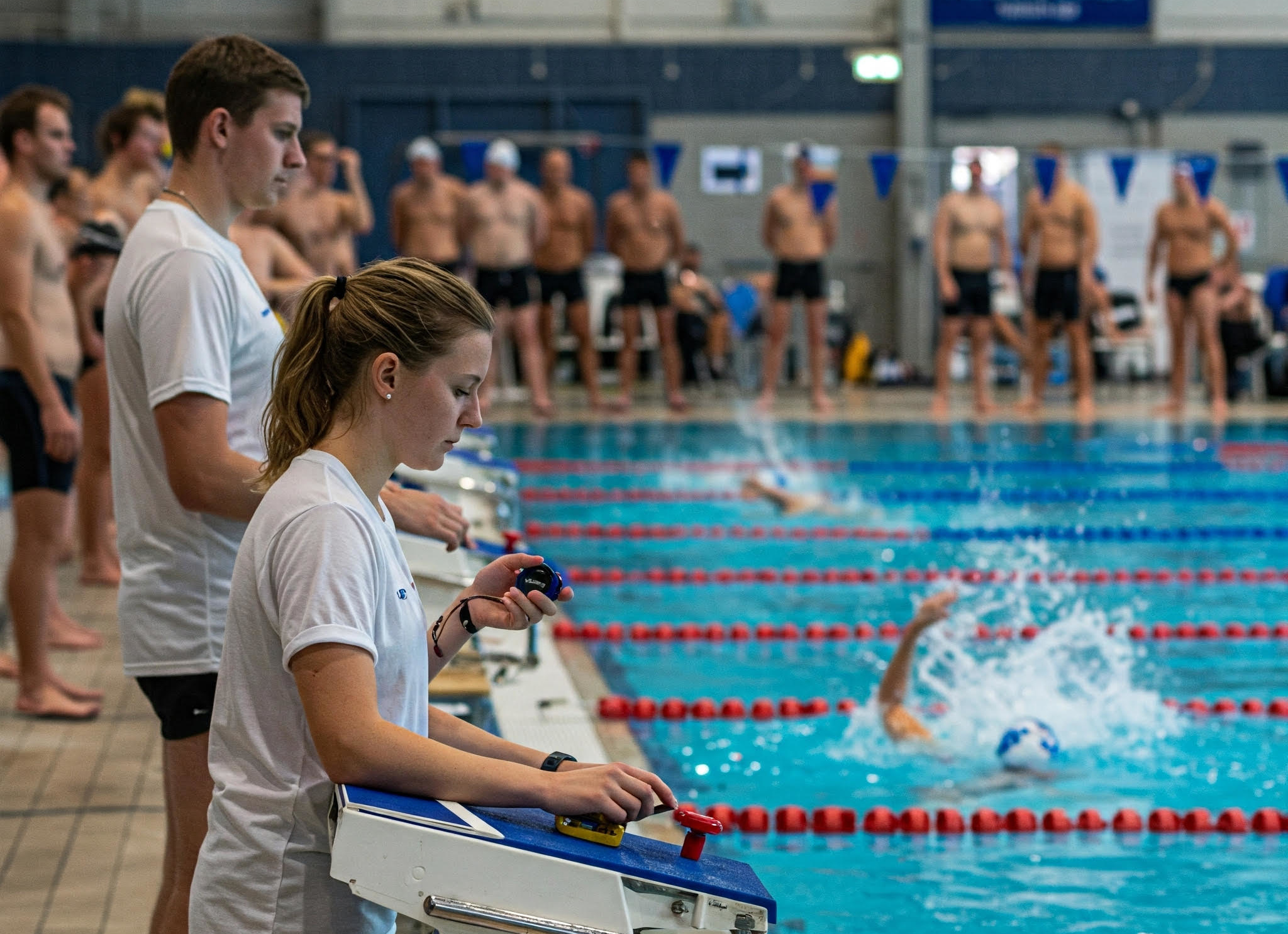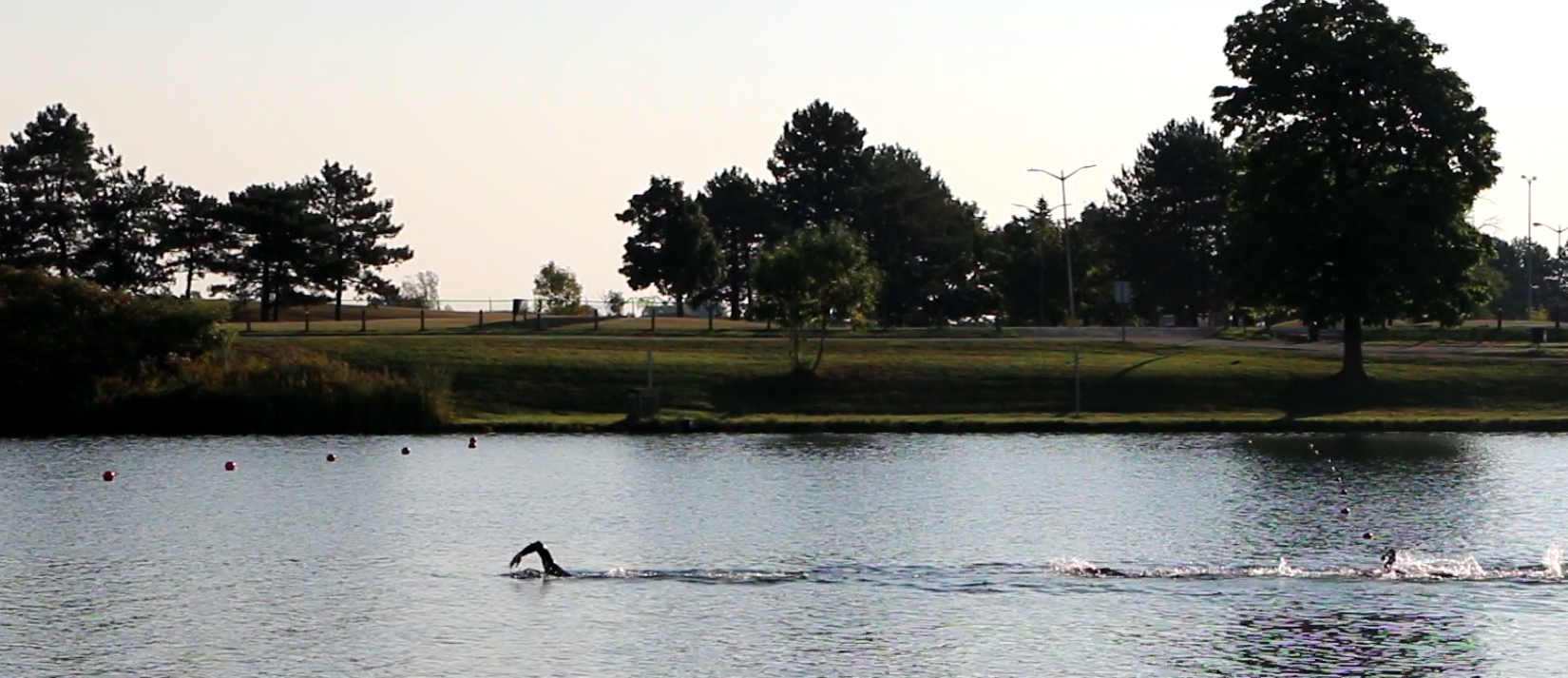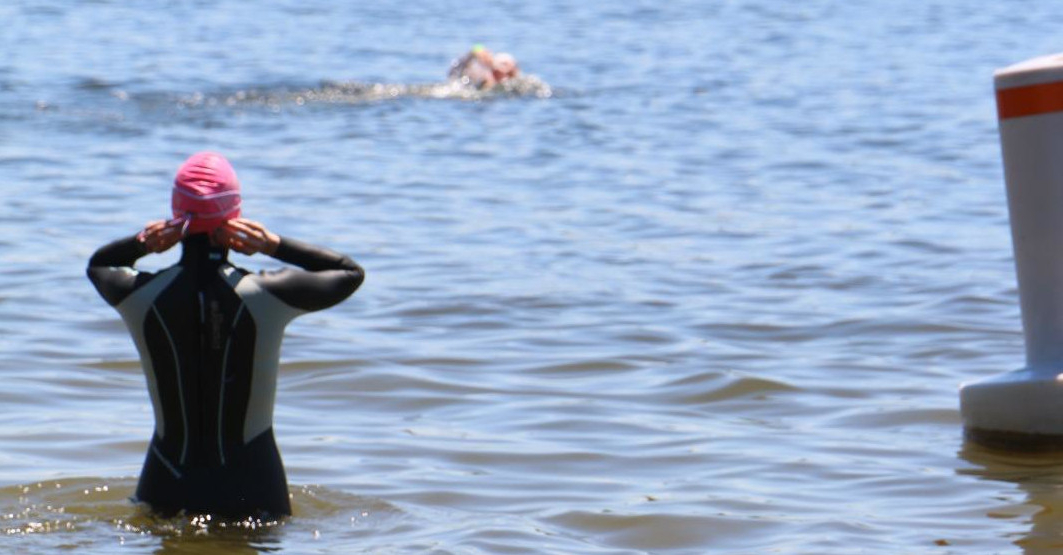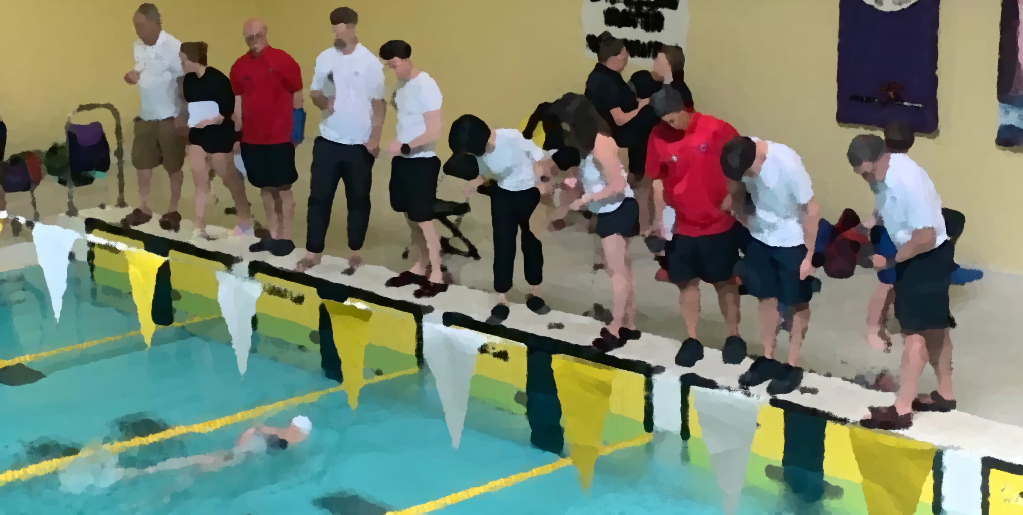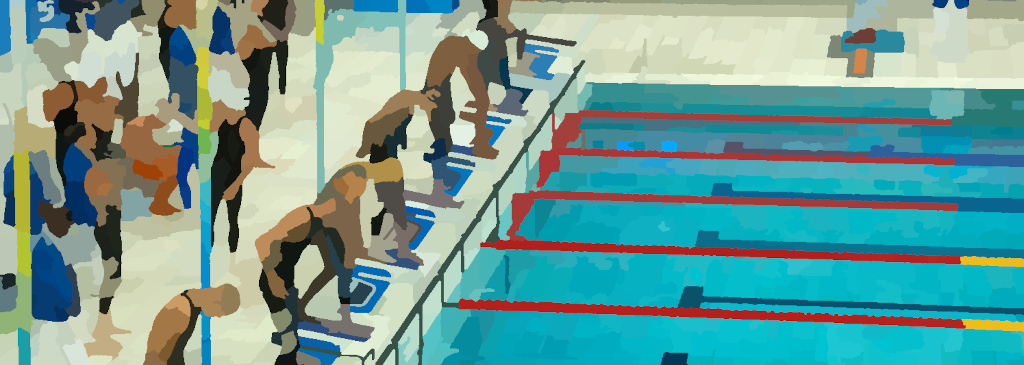The number 1 reason why swimmers attend swim meets is to get times. That's the best indication of their performance. Times could be a sign of progress from a previous meet, a personal best, a championship standard, or even a record. They are the reason swimmers get happy or sad, excited or frustrated. Given the relevance of these numbers, leaving a swim meet without them is unthinkable.
That's why the role of a timekeeper is so essential. Most competitive swimming pools in Canada are equipped with a timing system. It comes with touchpads and plungers. Touchpads provide the most accurate times because they are sensible to the swimmers' touch at the wall. However, they require minimal pressure, which sometimes might not happen. That's when the plungers come to the rescue. Two timekeepers are allocated per lane. Each one holds a plunger, pressing it when they see the swimmer's finish touch. Each plunger records a time, and the average between those times is used to replace the touchpad in case of soft touch. However, systems can fail, and the last resort is a battery-powered stopwatch, manually started and stopped by timekeepers, with the stop times noted in paper sheets. This redundancy is essential to ensure times are delivered to all swimmers in all events, and most of this redundancy is in the hands of timekeepers.
Timekeeping is also about precision. The more attentive and focused the timekeepers are, the more precise their times will be. So, effective timekeepers stay in the moment and react fast to what they see. Unfortunately, it is not that simple. The eyes send a hundred billion signals to the brain every second. Still, only about 10% of the information comes from the optic nerve. Other parts of the brain have to recognize, identify, and interpret things. So, the biggest part of seeing isn't receiving visual images; it's making sense of them, which takes up to two hundred milliseconds to complete. That's a considerable gap that would be easily noticeable if it wasn't for the brain continuously forecasting what the world will be like in a fifth of a second from now. Yes, it is hard to believe, but we never see the world as it is in this very instance; rather, we see it as it will be a fraction of a moment in the future. Having said that, why would we rely on people using stopwatches at all? The more we practice with the stopwatches at the touch on the wall, the faster the brain interprets those signals. The more focused we get, the more neurons are engaged in the sight. Combining the visual stimulus with hearing and touch considerably improves perception. We can quickly get as close as a hundred milliseconds or faster reactions. You may ask: "What about when my stopwatch matches the touchpad?" Well, that's just a coincidence.
6 Tips to Become More Effective
After a lot of deck experience as a timekeeper, I have compiled these six tips over the years that you can follow to become an effective timekeeper from day one:
-
Have good nights of sleep on the three days that precede the meet. You will feel rested and able to concentrate on the task at hand.
-
Review the slide deck of the timekeeper training to refresh your memory about the procedures and the role of a timekeeper. If you don't have a copy, you can find one on the Swim Canada website or ask your club for it.
-
The moment you get your hands on a stopwatch, start practising with it, getting used to the buttons and the positioning of your fingers. Do it until you no longer have to think about the basic operations. Your muscle memory will improve your reaction time.
-
Always start the stopwatch at the flash of the strobe light. Never rely on the start sound. Light reaches your eyes way faster than sound reaches your ears.
-
Always count the laps. You must be ready to stop the watch when the swimmer is finishing. Short events are easier to count, but distance events from 200m and above require more attention. Short course events have more to count than long course, but the long ones are less intense, which can lead to distractions.
-
If you are not confident about the start of your stopwatch, ask for assistance. The Chief Timekeeper is there to help, so raise your hand and let them take over the timing for that heat.
Applying to Volunteer as a Timekeeper
A few weeks before a swim meet, the hosting club sends a message to their swimming community, inviting them to volunteer for the upcoming swim meet. Reply to the invitation as soon as possible to increase your chances of participating, highlighting your interest in serving as a timekeeper. Most clubs offer family participation points to engage volunteers, so don't forget to take advantage of that.
In Canada, the dress code of a timekeeper is a white shirt, black pants, and black shoes or sandals.
Briefing With The Chief Timekeeper
The Chief Timekeeper is an official and experienced timekeeper who coaches and ensures the procedures are followed. The chief is there to help, not to oversee you. They run a briefing a few minutes before the session, and here is what you may hear during that time:
-
The Chief Timekeeper introduces themselves and explains that they are there to support the timekeepers and provide relief if they forget any part of the procedure or need to step away for a moment.
-
No phones are allowed on deck, but you can raise your hand to make or receive an urgent call. This way, the chief can temporarily replace you while you use the phone outside the deck.
-
Raise your hand if you see any problems with a swimmer, such as hitting their head on the wall, bleeding, or being out of breath. The Chief Timekeeper will contact the lifeguard to care for the swimmer while you prepare for the next heat.
-
Do not touch the swimmers, and keep the talking to a minimum. Swimmers are focused, and any distraction can deviate their attention from the race.
-
Look at the flash of the strobe to start the stopwatch. Do not rely on the sound of the starter since it propagates slower than light. If you have any delay to start, raise your hand for assistance.
-
Start the stopwatch even if there is no swimmer in your lane. You can help other timekeepers when they are not confident about their start.
-
The person who starts the stopwatch must stop it. Do not exchange a stopwatch once it starts.
-
Make sure you can see the wall at the finish, and do not step on the touchpad while doing that. It may send a false reading to the time system.
The Procedure on Deck
As a timekeeper in action, you will work in a team of two or three in your lane. You will split the following tasks among your peers:
-
Check the name and the heat of the swimmer. When checking the name, ask the swimmer to say it instead of reading it from the paper. If the lane is empty, write "NS" (No Show).
-
Before or at the sound of the referee whistle, reset the watch and get ready for the start by looking at the strobe light.
-
At the flash of the strobe light, start the stopwatch. If you are unsure about the start, raise your hand for assistance.
-
If requested by the Chief Timekeeper, record the splits of the swimmer at each lap by pressing the split button while the stopwatch is still running. Write the split times on paper.
-
Stop the stopwatch and press the plunger simultaneously at the final touch of the swimmer on the wall.
-
Write the final time on paper. If the swimmer did not finish, write "DNF".
Operating the Stopwatch
The stopwatch is a simple device, battery-operated, with three buttons that are easy to use. From the left to the right, they are:
-
Split/Reset: Records the split times and resets the stopwatch.
-
Mode: Switches between modes, such as time of the day, stopwatch, countdown, etc.
-
Start/Stop: Starts and stops the stopwatch.
Getting the Stopwatch Ready
When you get the stopwatch, make sure it is in the stopwatch mode. Press the mode button until you see many zeros on the display. If you see numbers incrementing, it means it is still running. So, press the stop button on the top right and then the reset button on the top left. Press the reset button on the top left if the numbers are not changing. The stopwatch should now be ready to go.
Using the Stopwatch
Before or at the sound of the referee's whistle, press the reset button on the top left and look at the strobe light. When it flashes, press the start button on the top right. The stopwatch will start counting up. Notice in the following image that there are two ways to hold the stopwatch:
-
With the thumb on the start button and the index finger on the split/reset button. That is the most common way to hold it. However, we can accidentally press the split/reset button when we want to start/stop the stopwatch. So, be careful with that.
-
With the index finger on the start button and the thumb supporting the device. That is the most secure way to hold it, but it may be uncomfortable for some people.
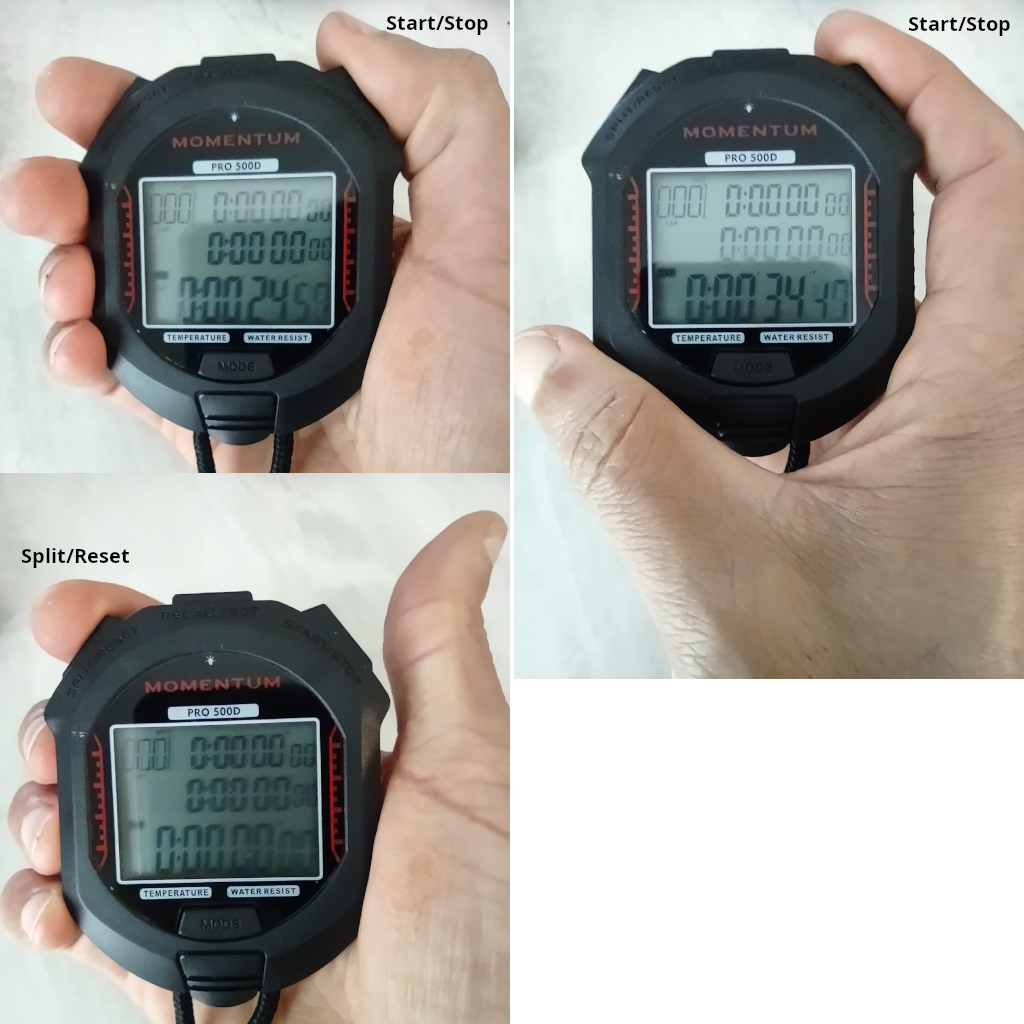
If split times are required, press the split/reset button on the top left every time the swimmer touches the wall at your end. The stopwatch will keep running.
Press the stop button on the top right when the swimmer touches the wall at the finish.
Returning the Stopwatch
When the session ends, reset the stopwatch and return it to the Chief Timekeeper.
Conclusion
A few milliseconds could be what separates a swimmer from their goals. So, the stakes are high when it comes to timing. As a timekeeper, your role is crucial in ensuring accurate and reliable timing. By practising effectiveness, following the procedures, and using the stopwatch effectively, you contribute to the proper measurement of the swimmer's performance and the overall success of the meet.
